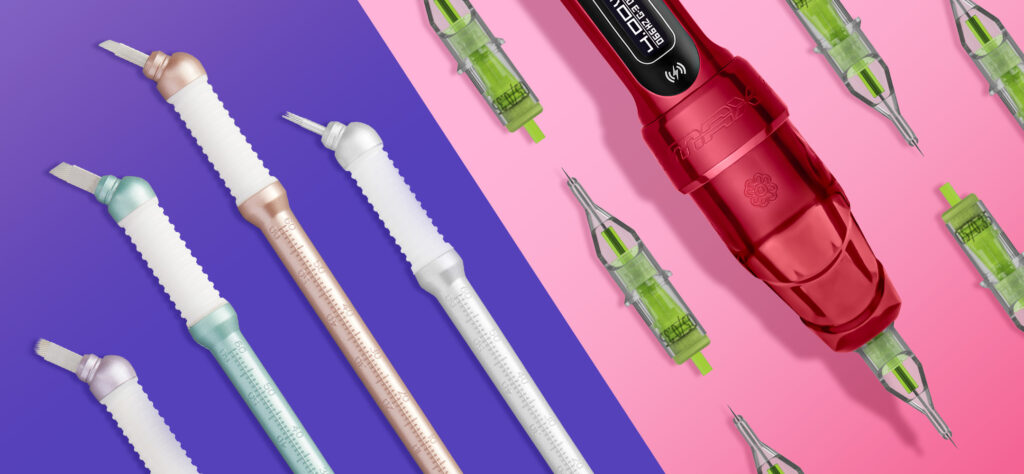Microblading vs Machines
If you’re thinking about starting as a permanent makeup artist, you might be looking at different training courses as well as building up your knowledge on different PMU treatments, such as eyebrow micropigmentation with a machine or microblading.
A lot of clients may not even be aware of there being more than one method for eyebrow treatments within PMU, so having a good knowledge of each treatment type is key to ensuring that your client fully understands the procedure they are having. They might also ask why you offer one method and not the other – so having a list of pros and cons for each technique means you are prepared for any questions that may come your way during a consultation!
Our helpful guide explores the difference between microblading vs machine brows and the pros and cons of both methods!
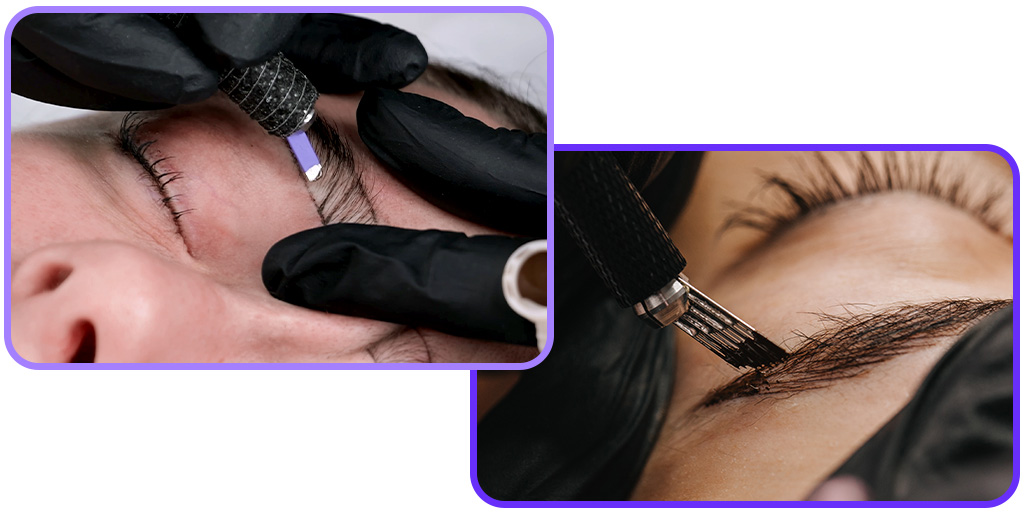
What Is Microblading?
Microblading involves using a microblade (which contains rows of tiny, sharp needles) attached to a manual hand tool to create incisions that deposit pigment into the skin. Microblading aims to mimic the appearance of natural hair strokes in the brows and gives a very natural result.
This treatment is one of the more original methods of cosmetic tattooing and has been around for a long time. It is also probably one of the most well-known permanent makeup procedures on the market, but it is limited to eyebrows only.
What Is The Machine Method?
The machine method, also known as micropigmentation, involves depositing pigment into the skin using a digital machine and a needle cartridge. Different to traditional tattoo machines, PMU machines typically have shorter stroke lengths and a softer ‘hit’ to work on the delicate skin of the face. PMU artists also use thinner/smaller needles to create finer details, compared to large areas covered in traditional tattooing.
This technique is newer than microblading but has exploded in popularity in recent years due to its versatility. With micropigmentation you can create shading, hair strokes, lines and much more across multiple treatments such as brows, lips, eyeliner, scalp, and areola. You are also free to create multiple different PMU styles with a digital machine such as ombré, hair stroke or combination brows.
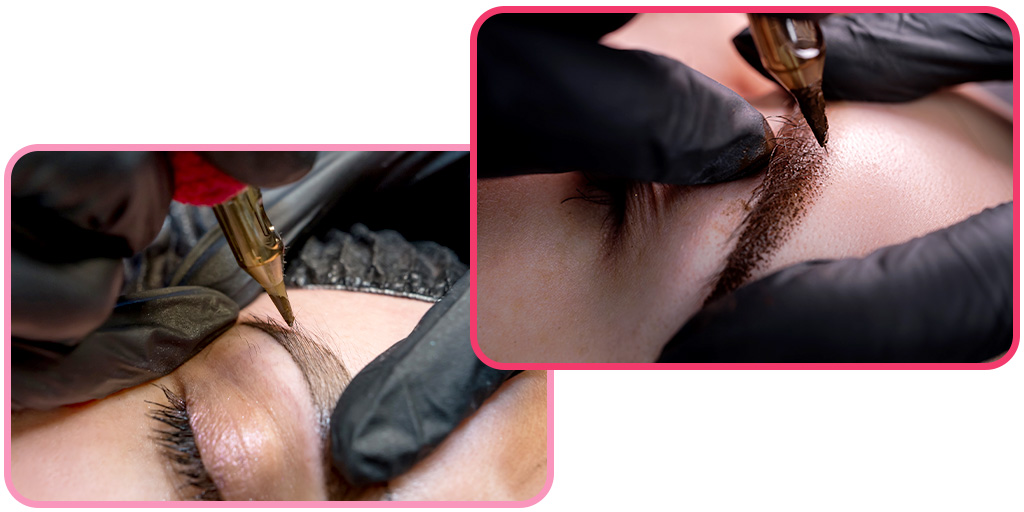
Microblading Pros & Cons
Pros
- Results are very soft and natural: Perfect for clients who want a subtle transformation and favour a fluffy brow look.
- Enhances the natural brow shape: Some clients may just request microblading strokes to fill in any sparse areas in the brow for understated brow results.
- Very well known: Due to the amount of time this treatment has been around, most clients will have heard of this technique and will feel confident having the procedure. Some clients may be wary to undergo a procedure using a newer PMU method which they have not heard of before.
Cons
- Not suitable for everyone: Microblading would not be the best option for clients with oily skin type as pigment may fade a lot quicker and more regular touch-ups could be required to maintain the results. There is also a risk of hairstrokes blurring into one another, creating a ‘block’ effect if the artist doesn’t have a full understanding of brow patterns and negative space.
- Can be considered more traumatic for the skin: Especially if clients have regular touch ups over a long period of time, it is believed that the incisions could lead to a higher risk of scar tissue developing. However, debates within the industry state that scarring and trauma are only a risk if treatment is performed incorrectly.
Machine Method Pros & Cons
Pros
- Versatility: Not only is machine work suitable for creating a range of styles, but it can also be used for a range of PMU treatments - not just brows.
- Suitable for all skin types: Healed results are thought to be longer-lasting than microblading, especially on clients with oily skin types and hair strokes are less likely to disperse within the skin and blur.
- Can replicate cosmetic makeup: The digital machine method is a great choice for clients who want to replicate their day-to-day makeup with powder brows, for example, to create a more polished look.
Cons
- Clients may be sceptical: If they are only familiar with microblading, they may be reluctant to undergo a treatment using a digital machine. They may also be put off by the bolder brow looks created with this method if they are wanting very natural results. Although soft & subtle brow strokes are still possible with the machine method – this may be a more difficult sell to a client who is set on microblading.
- Can be more expensive for a new artist: In comparison to microblades, the cost of a permanent makeup machine can be more expensive – especially when you are opting for a high-quality machine from a trusted, global brand. However, this is an investment into your career and business so it is 100% worthwhile, but it may not be within every beginner’s budget.
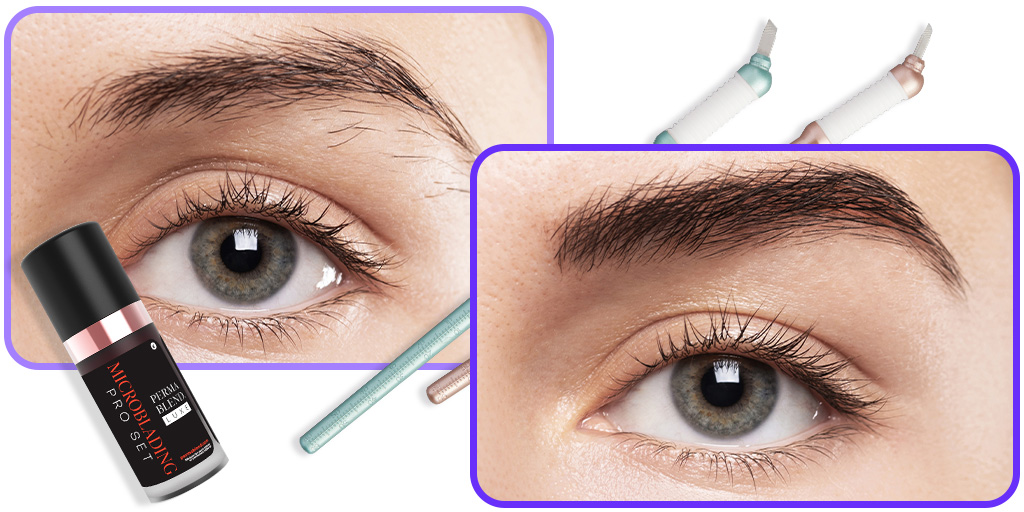
Hybrid or Combination Method
As permanent makeup techniques have developed over time, clients now have more choice than ever before. This means that clients do not have to choose between either natural hair stroke brows or bold powder brows – it’s possible to have a combination of both, known as combo brows, which combines hair strokes and shading techniques for a happy medium.
PMU artists who are trained in both microblading and machine work can combine these techniques for fluffy hair strokes and soft shading in the combination brow. However, in recent years there has been a surge in popularity of new nano-needles with digital machines – these are 1 round liners (single needles) with very small diameters for creating ultra-fine lines. This allows micropigmentation-trained artists to create realistic hair strokes using their PMU machine, and this can be used to create combination brows without the need for microblading. Find out more in our blog all about needle cartridges.
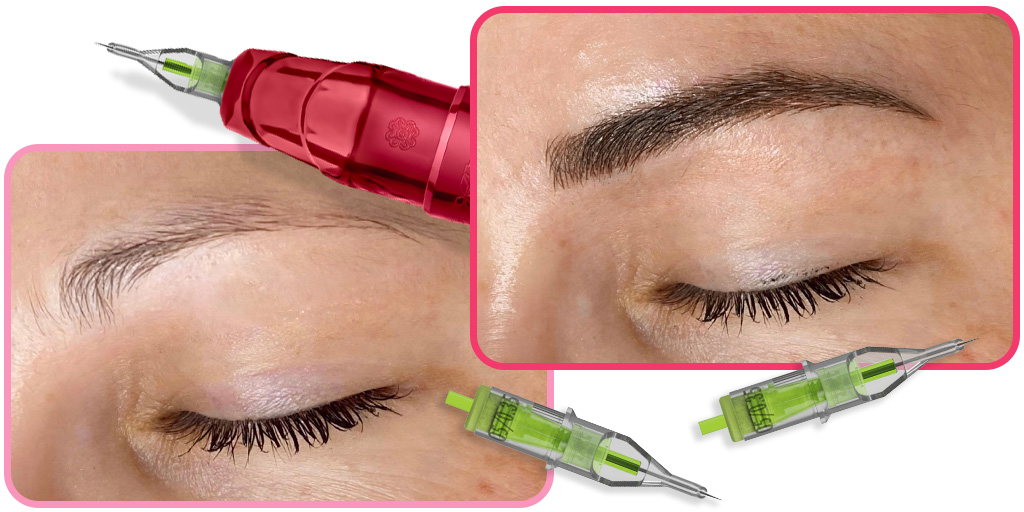
Which Method Is The Best Option For A Beginner?
There are pros and cons to both microblading and machine methods and you can create a successful permanent makeup business trained in either method, so the technique you opt for usually comes down to personal preference. You may also want to research which treatments are most popular in your area as trends and styles differ from place to place.
Understanding your ideal client will also help you understand what style of brow you are wanting to offer, which will determine the best method for your business. If you are hoping to appeal to more mature clients who want an undetectable result, then microblading would be a great choice. If you are aiming to book in younger clients who prefer a bolder, powder brow then machine would be the better option.
Some PMU artists start out with microblading initially as it is a lot easier to focus on one treatment (such as brows) and truly become an expert, plus it allows you to perfect your skills before considering any other treatments. It can also be more affordable if you are a beginner on a budget or you may just be a big fan of other successful microblading artists.
A lot of reputable academies offer microblading to machine conversion courses for confident microblading technicians who want to learn micropigmentation later in their career. Although you can create combination style brows using just the machine method, some artists do prefer microblade hair strokes over micropigmentation for an extra-fluffy effect so being trained in both can be a bonus and allow you to treat a larger range of clients.
When selecting training, it is important to do extensive research on becoming a cosmetic tattooer or PMU artist before you commit to a course.
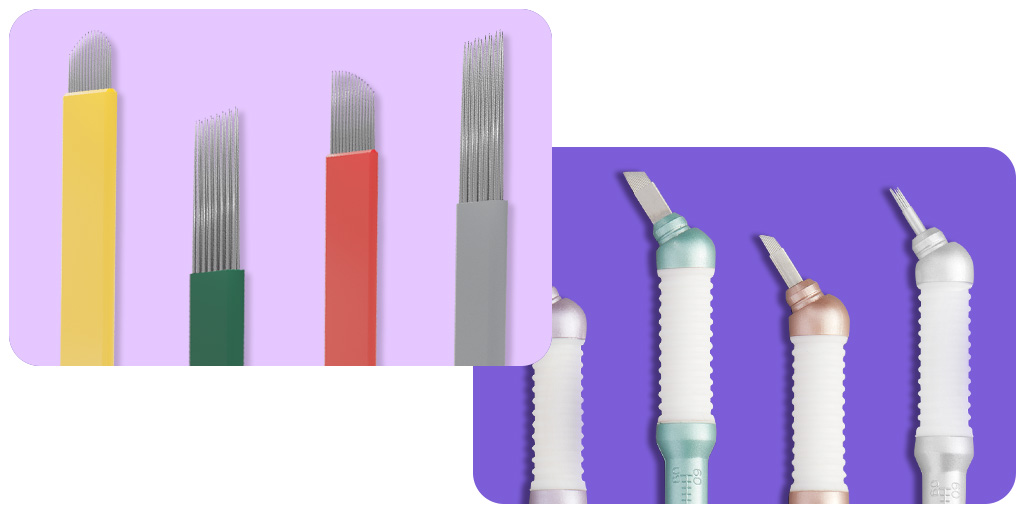
Microblading vs Machine Supplies
Whichever method you decide is the best option for you – investing in quality products is an absolute must!
Microblading:
- The Killer Beauty Microblades have been designed to create ultra-fine hair strokes with ease.
- Tina Davies Microblades come in a helpful sample pack containing Classic, Curved, U Needles and Shaders so you can try out the range of microblades designed for optimal pigment application.
- Jenna Boyd created a line of high-quality microblades that are perfect for creating a thin stroke to match up with fine and medium textured brown hair.
- Biotekmicroblades have been designed to create super crisp and precise hair strokes without causing excess trauma.
Cartridges:
- Stellar 2.0: The stability of the needle and pigment flow make these super sharp cartridges a great choice for machine brows as they can create the delicate details for hairstrokes or the soft powder effects for ombre.
Machines:
- Flux S Max:The Microbeau Flux S Max with a 3.2mm stroke length is perfect for various PMU treatments including eyebrows. It’s been designed to help artists create delicate fine lines in brow procedures.
- Bellar: The Microbeau Bellar PMU machine has been designed as a versatile machine suitable for different permanent makeup treatments, including eyebrow micropigmentation.
Pigments:
- Microblading Pro Set: Designed by Perma Blend LUXE, this set contains six versatile shades specifically designed for use in microblading treatments. The pigments have been created to provide long-lasting results for clients!
- Paulina Osinkowska Ombre Brows Set: Created in collaboration with Perma Blend LUXE, this set contains six pigments designed specifically to help artists create amazing Ombre or powder brows.
Choosing between machine brows and microblading is a personal decision for any new permanent makeup artist, and understanding the differences in technique, tools, and outcomes is crucial for success.
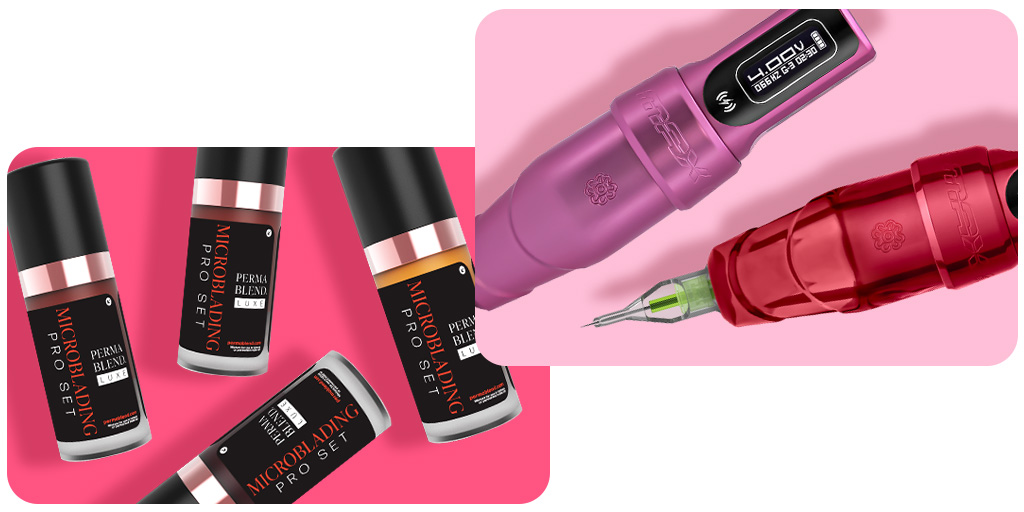
Both machine hair stroke brows and microblading offer unique benefits, with microblading known for its soft, natural look and ease for beginners, while machine methods deliver versatility and longer-lasting results, especially on oily skin. For those interested in a balanced approach, combination or hybrid brows offer the best of both worlds.
Regardless of the method, investing in quality equipment, pigments, and comprehensive training will ensure the best outcomes for your clients and establish a solid foundation for your PMU career.
